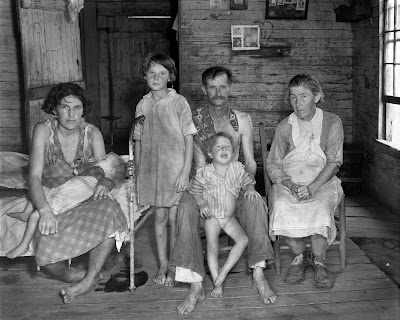
Several notable books on the South featuring work by major photographers, Southern and otherwise, are just out or due out in the next few months.
We've already mentioned Rebekah Jacob's forthcoming
Controversy and Hope: The Civil Rights Photographs of James Karales, about which there is
a lot more on Jacob's blog, here.
This book is due to be released any day now, and when it is we will do a blog entry on it. In the meantime, there is a portfolio of Karales' photographs on
the New York Times Lens blog, here.
Also looking toward the Southern past, the collaborative work by James Agee and Walker Evans called
Let Us Now Praise Famous Men is absolutely central to the history of photography in the American South.
Walker Evans' images (see examples, above), together with Agee's prose, not only document Southern working class life during the Great Depression but also establish a look, a style, an approach, and a subject matter for one kind of Southern photography.
Now, Agee's first effort to write about the South -- a 30, 000 word essay originally intended for publication in
Fortune magazine but never actually brought out -- will appear in book form as
Cotton Tenants: Three Families, from Melville House.
Evans' iconic photographs also accompany this new look at Agee's attempt to see clearly the experience of people in poverty in Alabama in the mid-1930's.
You can learn more about the book from
a story in today's New York Times, here, and see a portfolio of Evans' work,
on their Lens Blog, here.
Moving from the South of the past to the South of the present, two books are coming out this fall from the University of North Carolina Press that feature the work of North Carolina photographers.
The distinguished Durham, NC-based photographer
Titus Brooks Heagins has for a long time been documenting jazz, blues, and folk musicians of eastern North Carolina (see image above).
Now, his photographs will grace the pages of the new guide to
The African American Music Trails of Eastern North Carolina, with text by
Sarah Bryan and Beverly Patterson.
This book is being billed as a "travel guide" for "a fascinating
journey to music venues, events, and museums that illuminate the lives
of the musicians and reveal the deep ties between music and community.
"Interviews with more than 90 artists open doors to a world of music,
especially jazz, rhythm and blues, funk, gospel and church music, blues,
rap, marching band music, and beach music."
Heagins' images are stunning, vibrant, powerful witnesses to the richness of North Carolina's heritage and vitality as a center of music and the birthplace of important musicians.
Also, this fall, the UNC Press is publishing Raleigh, NC-based photographer
Lawrence Earley's The Work Boats of Core Sound: Stories and Photographs of a Changing World.
Earley's subject in this book is the distinctive culture of eastern North Carolina's fishing industry.
The combination of the Atlantic Ocean, the barrier islands, and the shallow sounds that define North Carolina's eastern boundary has given rise to a distinctive coastal culture of fishing and boat building.
Earley here documents -- in elegantly seen and powerfully rendered images -- the world of coastal North Carolina watermen through iconic images of their boats, mostly hand-made, mostly traditional in design.
You can find
a portfolio of Earley's images from this portfolio, here.
Earley combines his images with accounts of the watermen themselves, who remind us that traditions change as conditions the evoke traditional practices also change. Just as we are getting to a deeper understanding of the culture of coastal life, the combination of depleted fish stocks and the expansion of tourism in eastern North Carolina is threatening its continued existence.
So, in Earley's work there is both a celebratory and an elegiac quality. You can get a flavor of what he is about in
an essay on the UNC Press's website, here.
With engagement comes awareness and connection, if not understanding. In all these books we have much to look forward to.

















